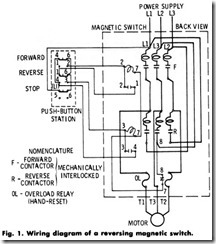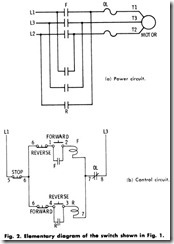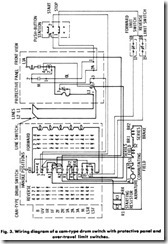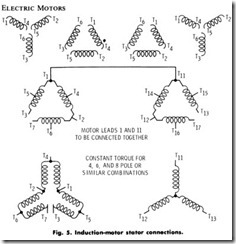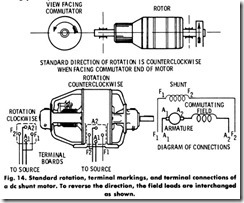Wiring Diagrams
The purpose of any wiring diagram is to indicate electric circuits by means of conventional symbols, thus making it possible to show the connections between various apparatus and instruments in a diagram matic form from which actual connections in the field may be made. In addition, wiring diagrams serve to make a permanent record of the wiring and apparatus installed, thus facilitating changes and replace ment. Diagrams also assist in the location of any trouble that may develop in the circuit after installation.
DIAGRAM DESIGN
The general procedure in laying out a circuit or diagram, especially one that is complicated, usually consists in working out an elementary or schematic diagram first, then making the working or general diagram from this layout. In an elementary diagram, no attention need be paid to the physical location of contactors or coils, but the strictest attention must be paid toward the electrical sequence of operation and to see that the equipment is correctly connected to operate properly. After a careful check of the elementary diagram has been made, the circuit is usually transferred to a working diagram where the relays, contactors, and other apparatus are laid out in a rear- view order, although the actual electrical connections conform in every detail with that of the elementary dia gram. Thus, the purpose of the elementary diagram is only to simplify the circuit for construction and checking.
In addition to elementary diagrams, there are several other types, each designed for a particular purpose or installation. The National Electrical Manufacturers Association (NEMA) and Institute of Elec trical and Electronics Engineers (IEEE) have made the following definitions:
Controller Wiring Diagram-A controller wiring diagram shows the electric connections between the parts comprising the controller and indicates the external connections.
Erternal Controller Wiring Diagram-An external controller wiring diagram shows the electric connections between the controller terminals and outside points, such as the connections from the line to the motor and to auxiliary devices.
Controller Construction Diagram-A controller construction dia gram indicates the physical arrangement of parts, such as wiring, busses, resistor units, etc.
Elementary Controller Wiring Diagram-An elementary con troller wiring diagram uses symbols and a plan of connections to illustrate, in simple form, the scheme of control.
Control Sequence Table-A control sequence table is a tabulation of the connections which are made for each successive position of the controller.
READING DIAGRAMS
Since wiring diagrams consist of symbols, it is most important that these be thoroughly understood. These basic symbols, which have been generally adopted by electric equipment manufacturers, are shown in the appendix. A study and understanding of these symbols by engi neers, wiremen, maintenance men, operators, and others who work with wiring diagrams will result in a saving of time and energy when determining how control equipment should be installed and how it is intended to operate. A knowledge of the symbols will make it easy to identify the devices and apparatus represented on the print, even though there may be little resemblance between the symbol used and the actual appearance of the device. It is general practice for a diagram to show devices in their de-energized position. The power and main motor circuits are usually indicated by heavy lines, while the control circuits are indicated by light lines.
Fig. 1 illustrates the connections of a typical ac reversing magnetic switch, push-button station, and induction motor. The magnetic switch contains two 3-pole contactors and a temperature overload relay. Each contactor has three normally open power contacts, a normally open electric interlock, and an operating coil. The relay includes two heaters connected in the power circuit, and a normally closed control-circuit contact. The complete symbol for the switch shows its electric parts in the same general relationship as they appear in the actual device.
When the FORWARD button is depressed (see Fig. 1), contactor F closes and applies power to the motor. A holding circuit for the coil ofF is established around the FORWARD push button by auxiliary interlock F.
The motor continues to run until shut down either by depressing the STOP button, by the tripping of the overload, or by a power failure.
Following an overload condition which causes relay OL to trip, it is necessary to reset the relay contact by hand before the motor can be restarted. Operation of the motor in the reverse direction is obtained by means of the REVERSE button. The back, or normally closed, contacts of the directional push-button units are used for electric interlocking and to prevent the coils of contactors F andR from being energized at the same time. With this arrangement, it is also possible to reverse the motor directly from the FORWARD and REVERSE buttons without first operating the STOP button.
To understand the operation of control equipment , it is necessary to have a complete idea of the circuits involved. As control systems and circuits become more complicated and require more devices, it is increasingly difficult to check the circuits and understand the operation from the conventional panel type of wiring diagram. For this reason, elementary or schematic diagrams are used. Since the main reason for this type of diagram is simplicity, the various electric elements of the devices are separated. They are shown in their respective functional position in the circuit without regard to their actual relationship in the device.
It is also customary to separate the power circuits from the control circuits. Elementary diagrams, which are often referred to as one-line diagrams, make it easy to visualize and understand the operation. They are particularly beneficial when troubleshooting or when changes be come necessary in the operation. For example, in some cases when large equipments are involved, the elementary circuits are shown on one print, and the detailed panel wiring and interconnections on separate prints. In other cases, the circuits may be shown in both elementary and detailed forms on a single print. An elementary diagram of the magnetic switch in Fig. 1 is illustrated in Fig. 2.
In controllers of the magnetic-switch type just described, the motor power circuits are handled by magnetically operated contactors under the control of a push- button station or other auxiliary device. In contrast to this type, there are different kinds of controllers which are manually operated. In these, the contacts which carry the main motor circuits are closed and opened by hand. Fig. 3 illustrates the connections of a manual drum switch of the cam type for use with a series-wound, direct-current motor. In this diagram, the letter X indicates that the contacts close when the handle moves to that particular position. Auxiliary control contacts UV, LSF, and LSR are closed when the switch handle is at the OFF position.
When the switch handle is moved to its first point forward, contacts 1F, 2F, and M close and apply power to the motor. When the handle is moved to the second position, contacts IF, 2 F, and M remain closed and, in addition, contact JA closes. In the third position, contact 2A also closes, and in the fourth position JA closes to completely short circuit the starting resistor. Returning the handle to its OFF position causes the previously mentioned contacts to open and disconnect the motor from the line. When the handle is moved to the REVERSE position,
contacts 1R, 2R and M close in the first position to energize the motor in the reverse direction.
Two control-type limit switches are shown in Fig. 3. The contacts of these switches are normally closed, but will assume an open position when the switches are tripped at their respective ends of travel.
The connections in Fig. 3 show not only the circuits of a manual cam-type drum switch, but also how undervoltage, overload, and directional overtravel protection can be obtained by the use of a protective panel, a push-button station, and control-type limit switches.
ABBREVIATIONS
Symbols for devices such as relays, contactors, switches, etc., are often marked to indicate the function or use of the particular device. The following abbreviations are used for device markings and designated as standards by the National Electrical Manufacturers Association (NEMA):
Armature accelerator. . . . . . . . . . . . . . . . . . . . . . . A
Armature shunt . . . . . . . . . . . . . . . . . . . . . . . . . AS
Auxiliary switch (breaker), normally open . . . . . . “a”
Auxiliary switch (breaker), norman y closed . . . . . . “b”
Balanced voltage . . . . . . . . . . . . . . . . . . . . . . . . BV
Brake . . . . . . . . . . . . . . . . . . . . . . . . . . . . . . . BR
Compensator-running . . . . . . . . . . . . . . . . . . . . MR
Compensator-starting. . . . . . . . . . . . . . . . . . . . . MS
Control . . . . . . . . . . . . . . . . . . . . . . . . . . . . . . CR
Door switch . . . . . . . . . . . . . . . . . . . . . . . . . . . OS
Down . . . . . . . . . . . . . . . . . . . . . . . . . . . . . . . . D
Dynamic braking . . . . . . . . . . . . . . . . . . . . . . . . DB
Field accelerator . . . . . . . . . . . . . . . . . . . . . . . . FA
Field decelerator . . . . . . . . . . . . . . . . . . . . . . . . FD
Field discharge . . . . . . . . . . . . . . . . . . . . . . . . . FD
Field dynamic brake . . . . . . . . . . . . . . . . . . . . . . OF
Field failure (loss of field) . . . . . . . . . . . . . . . . . . FL
Field forcing (decreasing on variable voltage) . . . . . . DF
Field forcing (increasing on variable voltage) . . . . . . CF
Field protective (field weakened at standstill) . . . . . . FP
Field reversing . . . . . . . . . . . . . . . . . . . . . . . . . FR
Field weakening . . . . . . . . . . . . . . . . . . . . . . . . FW
Final limit-forward . . . . . . . . . . . . . . . . . . . . . .FLF
Final limit-reverse . . . . . . . . . . . . . . . . . . . . . FLR
Final limit-hoist. . . . . . . . . . . . . . . . . . . . . . . FLH
Final limit-lower . . . . . . . . . . . . . . . . . . . . . . . FLL
Final 1imit-up . . . . . . . . . . . . . . . . . . . . . . . . FLU
Final limit-down . . . . . . . . . . . . . . . . . . . . . . FLO
Forward . . . . . . . . . . . . . . . . . . . . . . . . . . . . . . F
Full field . . . . . . . . . . . . . . . . . . . . . . . . . . . . . .FF
Generator field . . . . . . . . . . . . . . . . . . . . . . . . . GF
High speed. . . . . . . . . . . . . . . . . . . . . . . . . . . . HS
Hoist . . . . . . . . . . . . .. . . . . . . . . . . . . . . . . . . . H
Jam . . . . . . . . . . . . . . . . . . . . . . . . . . . . . . . . . .J
Kick off . . . . . . . . . . . . . . . . . . . . . . . . . . . . . KO
Landing. . . . . . . . . . . . . . . . . . . . . . . . . . . . . . LD
Limit switch . . . . . . . . . . . . . . . . . . . . . . . . . . . LS
Lowering . . . . . . . . . . . . . . . . . . . . . . . . . . . . . LT
Low speed . . . . . . . . . . . . . . . . . . . . . . . . . . . . LS
Low torque . . . . . . . . . . . . . . . . . . . . . . . . . . . LT
Low voltage . . . . . . . . . . LV
Main or line. . . . . . . . M
Master switch . . . . . . . . MS
Maximum torque . . . . . . . . MT
Middle landing . . . . . . . . . MLD
Motor field . . . . . . . . . MF
Overload. . . . . . . . . OL
Pilot motor .. . . . . . . . . PM
Plug .. . . . . . . . . p
Reverse .. . . . . . . . . R
Series relay .. . . . . . . . . SR
Slow down.. . . . . . . . . SD
Thermostat.. . . . . . . . . TS
Time .. . . . . . . . . T
up .. . . . . . . . . u
Undervoltage.. . . . . . . . . .UV
Voltage relay.. . . . . . . . . .VR
TERMINAL MARKINGS
The purpose of applying markings to the terminals of electric power apparatus, according to a standard, is to aid in making connections to other parts of the electric power system and to avoid improper connec tions that may result in unsatisfactory operation or damage. The markings are placed on, or directly adjacent to, terminals to which connection must be made from outside circuits or from auxiliary devices which must be disconnected for shipment. They are not intended to be used for internal machine connections.
Although the system of terminal markings (with letters and subscript numbers) gives information and facilitates the connecting of electrical machinery, there is the possibility of finding the terminals marked without a system or according to some system other than standard (especially on old machinery or machinery of foreign manufacture). There is a further possibility that internal connections have been changed or that errors were made in markings. It is therefore advisable before connecting any apparatus to a power source to make a check test for phase rotation, phase relation, polarity, and equality of potential.
The markings consist of a capital letter of the alphabet followed by a number subscript. The letter indicates the character or function of the winding which is brought to the terminal. A terminal letter followed by the subscript number 0 designates a neutral connection. Thus, To would be applied to the terminal connected to the neutral point of a stator winding.
AC Machines
Subscript number 1, 2, 3, etc., on ac machine terminals indicate the order of the phase succession for standard direction of rotation. The standard direction of rotation for ac generators and synchronous motors is clockwise when facing the end of the machine opposite the drive end. (It is customary to connect the coil windings and place collector rings on this end.)
Figs. 4, 5, and 6 show the terminal markings and connections for various types of ac motors and/or generators. The terminal letters assigned to the different windings are listed in the tables in the illustrations.
For induction motors, subscripts 1, 2, 3, etc., indicate the order of the succession of the phases. Thus, if induction-motor terminals T1, T2, TJ are respectively connected to ac generator terminals T1, T2, TJ, the generator will cause the induction motor to turn in the same direction. In a synchronous converter, the sequence of the subscripts 1, 2 and 3 applied to the collector-ring leads M1, M2, MJ indicate that, when the collector leads are connected to the correspondingly numbered termi nals of a three-phase generator, the standard rotation of the generator (clockwise, facing the end opposite the drive) will cause a clockwise rotation when viewing the direct-current or commutator end.
DC Machines
As applied to the terminals of the de windings of generators, motors, and synchronous converters, the subscript numbers indicate the direc tion of current in the windings. Thus, with a standard direction of rotation and polarity, the current in all windings will be flowing from 1 to 2, or from a lower to a higher number for example 3 to 4, etc. Figs. 7, 8, 9, and 10 show the terminal markings for various types of d motors and generators.
The standard direction of rotation for de generators is clockwise when facing the end of the machine opposite the drive (usually the commutator end of the machine) . The standard rotation for de motors is counterclockwise when facing the end opposite the drive (usually the commutator end).
Note 1-Any de machine can be used either as a generator or as a motor . For the desired direction of rotation, connection changes may be necessary. The conventions for current flow in combination with the standardization of opposite directions of rotation of de generators and de motors is such that any de machine can be called “generator” or “motor” without changing the terminal markings.
Note 2-A de motor and a de generator, by direct coupling, constitute a ·’motor-generator.” With such coupling, the direction of rotation of the motor and generator are necessarily reversed when each is viewed from the “end opposite the drive.” The standardized clockwise rotation for de generators and counterclockwise for de motors meets such coupling requirements without changing the standard connections or rotation for either machine. Similarly, a de motor may be mechanically coupled to an ac generator without changing from the standard for either individual machine. However, the coupling of an ac motor to a de generator cannot be made without rotation other than standard for one of the two machines. Since the rotation of the ac machine is usually easier to change, it is general practice to operate a motor-generator with a clockwise rotation viewed from the generator end.
Transformers
On single-phase transformers, the subscript indicates the polarity relation between the terminals on the primary and secondary windings. Thus, during that part of the ac cycle when high-tension terminal H1 is positive ( +) with respect to H2 , the low-tension terminal X1 is positive with respect to X2 . The idea is further carried out on single-phase
transformers having tapped windings by applying the subscripts 1, 2, 3, 4, 5, etc., to the taps so that the potential gradient follows the sequence of the subscript numbers. Figs. 11, 12, and 13 show the standard terminal markings of various transformers.
Note 3-When the primary of a transformer receives energy through the connecting leads, the secondary delivers energy to its connected circuit. However, the direction of current in the winding is reversed with respect to the polarity of the voltage at the terminals. It is important to take note of the difference between the practice applying subscripts to de generator and motors, where the subscripts are assigned according to the direction of current, and to the case of single-phase transformers, where subscripts re assigned according to terminal voltage.
In the case of polyphase transformers, the terminal subscripts are applied so that if the phase sequence of voltage on the high-voltage side is in the time order of H1 , H2 , H3 , etc. , it is in the time order of X1, X2 , X3 , etc., on the low-voltage side, and also in the time order of X1 , Y2 , Y3 etc. , if there is a tertiary winding.
Note 4-The terminal markings of polyphase transformers affords informa tion on how phase rotation is carried through the transformer, but does not disclose completely the phase relations between correspondingly numbered primary and secondary terminals. Consequently, additional information on internal connections is required before polyphase transformers can be safely paralleled Ac generators driven counterclockwise (clockwise is standard) will generate without change in connections, but the phases will follow the sequence of 3, 2, 1 instead of sequence 1, 2, 3.
Synchronous motors, synchronous condensers, induction motors, and synchronous converters may be operated with reversed rotation by transposing the connections so that the phase sequence of the polyphase supply is applied to the terminals in reversed order, that is, 3, 2, 1.
De generators with connections properly made for standard rotation (clockwise) will not function if driven counterclockwise, as any small current delivered by the armature tends to demagnetize the fields and thus prevent the armature from delivering current. If conditions call for reversed rotation, connections should be made with either the armature leads transposed or the field leads transposed, but not both.
The polarity of a de generator, with the accompanying direction of current in the several windings, is determined by theN andS polarity of the residual magnetism. Accident, or special manipulations may reverse this magnetic polarity. Though the generator itself will function as well with either polarity, an unforeseen change may cause a disturbance or damage when it is connected to other generators or devices.
The direction of rotation of de motors depends not on absolute polarity, but on a relative polarity between the field and armature. As no dependence is placed on residual magnetism for determining the initial direction of rotation, it is not necessary, when connecting de motors, to regard the polarity of the de supply connections. With a standard direction of rotation, if current is found to be flowing from terminal/ to 2 in one of the windings, it will be found that in all the other windings as flowing from 1 to 2. But, because of the disregard of polarity in connecting de motors, the current is as likely to be flowing from terminal 2 to terminal 1 in each of the several windings.
Reversal of rotation of a de motor is obtained by a transposition of the two armature leads or by a transposition of the field leads (Fig. 14). With such reversed rotation (clockwise), when the polarity of the supply makes the direction of the current in the armature from terminal2 to 1, it will be flowing in the field windings from terminal 1 to 2, and vice versa.
With synchronous converters, the practice of ac starting eliminates residual magnetism as the factor determining de polarity. Proper polar ity for connection to other apparatus is secured either by separate excitation of the field or by special manipulation of a switch which permits the converter to reverse polarity, thus correcting a start with wrong polarity.
If a synchronous converter is to be operated with reversed direction of rotation (counterclockwise, viewing the commutator end), besides transposing the ac terminal connections, it is also necessary to make either a transposition of armature leads or a transposition of field leads.
WIRING SYMBOLS
The symbols used on wiring diagrams to represent various electrical devices facilitate not only the reading and understanding, but also the maintenance and installation of electrical equipment of all kinds. Various fundamental symbols commonly found on wiring diagrams and employed by representative electrical manufacturers are given in the Appendix. The fundamental symbols represent component parts such as coils, connections, contacts, instruments, transformers, etc., and can be combined in various ways to represent complete electrical devices.
SUMMARY
Wiring diagrams are used to show the connections of electrical circuits and components in a form that is much easier to interpret than the actual wiring. Components, such as resistors, capacitors, switches, etc., are represented by standardized symbols to further simplify the diagrams. The symbols used for electrical diagrams often differ from those used for electronic diagrams. This should be kept in mind in order to avoid confusion.
The location of the various symbols on the wiring diagram does not necessarily indicate their actual location in the electrical equipment. Instead, the correct electrical connections are the primary concern.
Symbols are often marked with an abbreviation to indicate the function of the component or device they represent. Abbreviations that have been designated as standard are used. Terminal markings for the terminals of motors, generators, and transformers have also been standardized. These markings consist of a capital letter and a number subscript, the combination indicating the character or function of the winding connected to the terminal. The use of terminal markings reduces the possibility of error when wiring equipment, as well as simplifying and speeding up the procedure. Terminal markings furnish other information, such as the order of phase succession, the direction of rotation, and the direction of current flow in de machines.
The standard direction of rotation for ac generators and synchronous motors is clockwise when facing the end of the machine opposite the drive end. The standard direction of rotation for de generators is clockwise when facing the end of the machine opposite the drive end. The rotation of de motors is exactly opposite–counterclockwise when viewed from the end that is not driving.
REVIEW QUESTIONS
1. Why are diagrams used to indicate electrical circuits?
2. In a wiring diagram that includes both power and control circuits, which circuits are generally drawn with heavy lines?
3. What is the purpose of the terminal marking on an ac three-phase motor?
4. How may a three-phase induction motor be reversed?
5. How may a de motor be reversed?
